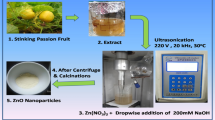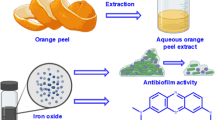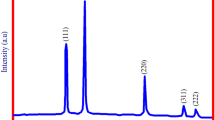Abstract
In this study the catalytic ability of green synthesized nickel oxide nanoparticles (NiO NPs) is investigated for degradation of methyl orange as a hazardous environmentally contamination in water. The NiO NPs was prepared at ambient conditions using the antioxidant content of Punica granatum L. (pomegranate) juice extract and their bio-reducing ability were studied in details. This process is entirely green process, free from toxic and hazardous solvent. The biosynthesized NiO NPs were in nano scale and their morphology, sizes, surface area and optical properties were characterized using field emission scanning electron microscope (FE-SEM), BET surface area analysis, thermogravimetric analysis, energy dispersive x-ray spectroscopy (EDX), X-ray diffraction (XRD) and ultraviolet–visible spectroscopy (UV–Vis). The biosynthesized NiO NPs were found to be active catalysts, particularly with the reducing agents for instance sodium borohydride, for the degradation of the toxic organic dyes such as methyl orange (MO) in contaminated water. The NiO NPs are stable and reusable for reducing MO to its leuco-form, in a short time, in an aqueous medium in the absence of reducing agents. This method is much cheaper than the other methods. The catalytic activity of NiO NPs can be explained by its small size, compared with the bulk materials, which produce numerous active sites due to its big surface area per unit volume.















Similar content being viewed by others
References
I. Khan, K. Saeed, I. Khan, Nanoparticles: properties, applications and toxicities. Arab. J. Chem. 12(7), 908–931 (2019)
R. Parker, Quantum Confinement: Effects, Observations and Insights (Nova Science Publishers, Incorporated, 2017)
D. Zhang, Y. Jin, Y. Cao, Facile synthesis and ammonia gas sensing properties of NiO nanoparticles decorated MoS2 nanosheets heterostructure. J. Mater. Sci.: Mater. Electron. 30(1), 573–581 (2019)
D. Zhang et al., Characterization of nickel oxide decorated-reduced graphene oxide nanocomposite and its sensing properties toward methane gas detection. J. Mater. Sci.: Mater. Electron. 27(4), 3723–3730 (2016)
M. Alagiri, S. Ponnusamy, C. Muthamizhchelvan, Synthesis and characterization of NiO nanoparticles by sol–gel method. J. Mater. Sci.: Mater. Electron. 23(3), 728–732 (2012)
E. Azaceta et al., One-step wet chemical deposition of NiO from the electrochemical reduction of nitrates in ionic liquid based electrolytes. Electrochim. Acta 96, 261–267 (2013)
C. Schoeberl, M. Manolova, R. Freudenberger, Sol-gel-deposited cobalt and nickel oxide as an oxygen evolution catalyst in alkaline media. Int. J. Hydrog. Energy 40(35), 11773–11778 (2015)
S.S. Ahmed, E.K. Hassan, G.H. Mohamed, Investigation of optical properties of NiO0.99Cu0.01 thin film by thermal evaporation. Int. J. 2(2), 633–638 (2014)
D. Siingh et al., The atmospheric global electric circuit: an overview. Atmos. Res. 84(2), 91–110 (2007)
F. Motahari, M.R. Mozdianfard, M. Salavati-Niasari, Synthesis and adsorption studies of NiO nanoparticles in the presence of H2acacen ligand, for removing Rhodamine B in wastewater treatment. Process Saf. Environ. Prot. 93, 282–292 (2015)
A.A. Ezhilarasi et al., Green synthesis of NiO nanoparticles using Moringa oleifera extract and their biomedical applications: cytotoxicity effect of nanoparticles against HT-29 cancer cells. J. Photochem. Photobiol. B 164, 352–360 (2016)
X. Xu et al., YSZ thin films deposited by spin-coating for IT-SOFCs. Ceram. Int. 31(8), 1061–1064 (2005)
P. Raveendran, J. Fu, S.L. Wallen, Completely “green” synthesis and stabilization of metal nanoparticles. J. Am. Chem. Soc. 125(46), 13940–13941 (2003)
O.V. Kharissova et al., The greener synthesis of nanoparticles. Trends Biotechnol. 31(4), 240–248 (2013)
K. Parveen, V. Banse, L. Ledwani, Green synthesis of nanoparticles: their advantages and disadvantages, in AIP Conference Proceedings (AIP Publishing, 2016)
Z. Monsef Khoshhesab, K. Gonbadi, G. Rezaei Behbehani, Removal of reactive black 8 dye from aqueous solutions using zinc oxide nanoparticles: investigation of adsorption parameters. Desalin Water Treat 56(6), 1558–1565 (2015)
G. Mezohegyi et al., Advanced bioreduction of commercially important azo dyes: modeling and correlation with electrochemical characteristics. Ind. Eng. Chem. Res. 48(15), 7054–7059 (2009)
U.G. Akpan, B.H. Hameed, Parameters affecting the photocatalytic degradation of dyes using TiO2-based photocatalysts: a review. J. Hazard. Mater. 170(2–3), 520–529 (2009)
H.M. Pinheiro, E. Touraud, O. Thomas, Aromatic amines from azo dye reduction: status review with emphasis on direct UV spectrophotometric detection in textile industry wastewaters. Dyes Pigm. 61(2), 121–139 (2004)
A. Bhankhar et al., Study on degradation of methyl orange-an azo dye by silver nanoparticles using UV–Visible spectroscopy. Indian J. Phys. 88(11), 1191–1196 (2014)
K.-T. Chung, Azo dyes and human health: a review. J. Environ. Sci. Health Part C 34(4), 233–261 (2016)
S. Hildenbrand et al., Azo dyes and carcinogenic aromatic amines in cell cultures. Int. Arch. Occup. Environ. Health 72(3), M052–M056 (1999)
S. Zhu et al., High adsorption capacity for dye removal by CuZn hydroxyl double salts. Environ. Sci.: Nano 1(2), 172–180 (2014)
M. Rani, U. Shanker, Photocatalytic degradation of toxic phenols from water using bimetallic metal oxide nanostructures. Coll. Surf. A: Physicochem. Eng. Asp. 553, 546–561 (2018)
V.M. Correia, T. Stephenson, S.J. Judd, Characterisation of textile wastewaters-a review. Environ. Technol. 15(10), 917–929 (1994)
A.A. Prasada, G. Kumara, D.M. Thomasb, Bulletin of chemical and pharma research. Bull. Chem. Pharma Res 1(1), 30–39 (2017)
M. Tarrago et al., Valorization of sludge from a wastewater treatment plant by glass-ceramic production. Ceram. Int. 43(1), 930–937 (2017)
J. Niu et al., Effects of environmental factors on sulfamethoxazole photodegradation under simulated sunlight irradiation: kinetics and mechanism. J. Environ. Sci 25(6), 1098–1106 (2013)
E. Kalkan et al., Removal of textile dye Reactive Black 5 from aqueous solution by adsorption on laccase-modified silica fume. Desalin. Treat 52(31–33), 6122–6134 (2014)
J. Vijayaraghavan, S.S. Basha, J. Jegan, A review on efficacious methods to decolorize reactive azo dye. J. Urban Environ. Eng. 7(1), 30–47 (2013)
Z. Sadowski, A. Pawlowska, Synthesis of metal oxide nanoparticles and its biomedical applications, in Nanotechnology Applied to Pharmaceutical Technology (Springer, Berlin, 2017), pp. 91–111
C. Mohammadi et al., Green synthesis of ZnO nanoparticles using the aqueous extract of Euphorbia petiolata and study of its stability and antibacterial properties. Moroc. J. Chem. 5(3), 476–484 (2017)
Q. Zhang et al., CuO nanostructures: synthesis, characterization, growth mechanisms, fundamental properties, and applications. Prog. Mater Sci. 60, 208–337 (2014)
A. Tadjarodi et al., Preparation of CdO rhombus-like nanostructure and its photocatalytic degradation of azo dyes from aqueous solution. Nanomater. Nanotechnol. 4(Godište 2014), 4–16 (2014)
M. El-Kemary, N. Nagy, I. El-Mehasseb, Nickel oxide nanoparticles: synthesis and spectral studies of interactions with glucose. Mater. Sci. Semicond. Process. 16(6), 1747–1752 (2013)
M. Hassanpour et al., Microwave synthesis of CuO/NiO magnetic nanocomposites and its application in photo-degradation of methyl orange. J. Mater. Sci.: Mater. Electron. 27(3), 2718–2727 (2016)
M. Imran Din, A. Rani, Recent advances in the synthesis and stabilization of nickel and nickel oxide nanoparticles: a green adeptness. Int. J. Anal. Chem. (2016). https://doi.org/10.1155/2016/3512145
K. Ukoba, A. Eloka-Eboka, F. Inambao, Review of nanostructured NiO thin film deposition using the spray pyrolysis technique. Renew. Sustain. Energy Rev. 82, 2900–2915 (2017)
M. Hassanpour, H. Safardoust-Hojaghan, M. Salavati-Niasari, Rapid and eco-friendly synthesis of NiO/ZnO nanocomposite and its application in decolorization of dye. J. Mater. Sci.: Mater. Electron. 28(15), 10830–10837 (2017)
M. Ramesh et al., Adsorption and photocatalytic properties of NiO nanoparticles synthesized via a thermal decomposition process. J. Mater. Res. 33(5), 601–610 (2018)
A.A. Ezhilarasi et al., Green synthesis of NiO nanoparticles using Aegle marmelos leaf extract for the evaluation of in-vitro cytotoxicity, antibacterial and photocatalytic properties. J. Photochem. Photobiol., B 180, 39–50 (2018)
Z. Sabouri et al., Facile green synthesis of NiO nanoparticles and investigation of dye degradation and cytotoxicity effects. J. Mol. Struct. 1173, 931–936 (2018)
P. Kganyago et al., Synthesis of NiO nanoparticles via a green route using Monsonia burkeana: the physical and biological properties. J. Photochem. Photobiol. B 182, 18–26 (2018)
F.L.A. Hossin, Effect of pomegranate (Punica granatum) peels and it’s extract on obese hypercholesterolemic rats. Pak. J. Nutr. 8(8), 1251–1257 (2009)
M. Viladomiu et al., Preventive and prophylactic mechanisms of action of pomegranate bioactive constituents. Evid.-Based Complement. Altern. Med. 2013. https://doi.org/10.1155/2013/789764
M. Viuda-Martos, J. Fernández-López, J. Pérez-Álvarez, Pomegranate and its many functional components as related to human health: a review. Compr. Rev. Food Sci. Food Saf. 9(6), 635–654 (2010)
N.A.N. Mohamad, et al., Plant extract as reducing agent in synthesis of metallic nanoparticles: a review, in Advanced Materials Research (Trans Tech Publ, 2014)
M. Nasrollahzadeh et al., Biosynthesis of the palladium/sodium borosilicate nanocomposite using Euphorbia milii extract and evaluation of its catalytic activity in the reduction of chromium (VI), nitro compounds and organic dyes. Mater. Res. Bull. 102, 24–35 (2018)
S.M. Sajadi et al., Green synthesis of the Ag/bentonite nanocomposite using Euphorbia larica extract: a reusable catalyst for efficient reduction of nitro compounds and organic dyes. ChemistrySelect 3(43), 12274–12280 (2018)
A. Barzinjy, S. Mustafa, H. Ismael, Characterization of ZnO NPs prepared from green synthesis using Euphorbia Petiolata leaves. EAJSE 4, 74–83 (2019)
A.A. Barzinjy et al., Green synthesis of the magnetite (Fe3O4) nanoparticle using Rhus coriaria extract: a reusable catalyst for efficient synthesis of some new 2-naphthol bis-Betti bases. Inorg. Nano-Met. Chem. (2020). https://doi.org/10.1080/24701556.2020.1723027
V. Makarov et al., “Green” nanotechnologies: synthesis of metal nanoparticles using plants. Acta Naturae (aнглoязычнaя вepcия) 6(1), 20 (2014)
A.M. Youssef Moustafa, A.I. Khodair, M.A. Saleh, Isolation, structural elucidation of flavonoid constituents from Leptadenia pyrotechnica and evaluation of their toxicity and antitumor activity. Pharm. Biol. 47(6), 539–552 (2009)
I. Bibi et al., Green synthesis of iron oxide nanoparticles using pomegranate seeds extract and photocatalytic activity evaluation for the degradation of textile dye. J. Mater. Res. Technol. 8(6), 6115–6124 (2019)
A. Rahdar, M. Aliahmad, Y. Azizi, NiO nanoparticles: synthesis and characterization. J. Nanostruct. 5(2), 145–151 (2015)
G.A. Babu et al., An investigation of flower shaped NiO nanostructures by microwave and hydrothermal route. J. Mater. Sci.: Mater. Electron. 25(12), 5231–5240 (2014)
B.D. Viezbicke et al., Evaluation of the Tauc method for optical absorption edge determination: ZnO thin films as a model system. physica status solidi (b) 252(8), 1700–1710 (2015)
K. Varunkumar et al., Effect of calcination temperature on Cu doped NiO nanoparticles prepared via wet-chemical method: structural, optical and morphological studies. Mater. Sci. Semicond. Process. 66, 149–156 (2017)
N.M. Hosny, Synthesis, characterization and optical band gap of NiO nanoparticles derived from anthranilic acid precursors via a thermal decomposition route. Polyhedron 30(3), 470–476 (2011)
Z. Parsaee, Synthesis of novel amperometric urea-sensor using hybrid synthesized NiO-NPs/GO modified GCE in aqueous solution of cetrimonium bromide. Ultrason. Sonochem. 44, 120–128 (2018)
A.N. Ejhieh, M. Khorsandi, Photodecolorization of Eriochrome Black T using NiS–P zeolite as a heterogeneous catalyst. J. Hazard. Mater. 176(1–3), 629–637 (2010)
Z. Sabouri et al., Plant-based synthesis of NiO nanoparticles using salvia macrosiphon Boiss extract and examination of their water treatment. Rare Met. (2019). https://doi.org/10.1007/s12598-019-01333-z
M. Sadeghi et al., Decontamination of toxic chemical warfare sulfur mustard and nerve agent simulants by NiO NPs/Ag-clinoptilolite zeolite composite adsorbent. J. Environ. Chem. Eng. 4(3), 2990–3000 (2016)
A.C. Gandhi, S.Y. Wu, Strong deep-level-emission photoluminescence in NiO nanoparticles. Nanomaterials 7(8), 231 (2017)
A. Barakat et al., One step synthesis of NiO nanoparticles via solid-state thermal decomposition at low-temperature of novel aqua (2,9-dimethyl-1,10-phenanthroline) NiCl2 complex. Int. J. Mol. Sci. 14(12), 23941–23954 (2013)
S.A. Speakman, Estimating crystallite size using XRD.
A.K. Zak et al., X-ray analysis of ZnO nanoparticles by Williamson-Hall and size–strain plot methods. Solid State Sci. 13(1), 251–256 (2011)
S. Agrawal, A. Parveen, A. Azam, Microwave assisted synthesis of Co doped NiO nanoparticles and its fluorescence properties. J. Lumin. 184, 250–255 (2017)
J. Al Boukhari, A. Khalaf, R. Awad, Structural and electrical investigations of pure and rare earth (Er and Pr)-doped NiO nanoparticles. Appl. Phys. A 126(1), 74 (2020)
S. Brunauer, P.H. Emmett, E. Teller, Adsorption of gases in multimolecular layers. J. Am. Chem. Soc. 60(2), 309–319 (1938)
M.R. Kalaie et al., Preparation and characterization of superparamagnetic nickel oxide particles by chemical route. Appl. Nanosci. 6(6), 789–795 (2016)
R.K. Sharma, R. Ghose, Synthesis of porous nanocrystalline NiO with hexagonal sheet-like morphology by homogeneous precipitation method. Superlattices Microstruct. 80, 169–180 (2015)
C.R. Kumar et al., Photocatalytic, nitrite sensing and antibacterial studies of facile bio-synthesized nickel oxide nanoparticles. J. Sci.: Adv. Mater. Devices (2020). https://doi.org/10.1016/j.jsamd.2020.02.002
C.R. Kumar et al., One-pot green synthesis of ZnO–CuO nanocomposite and their enhanced photocatalytic and antibacterial activity. Adv. Nat. Sci.: Nanosci. Nanotechnol. 11(1), 015009 (2020)
H. Hu et al., Satellite-like CdS nanoparticles anchoring onto porous NiO nanoplates for enhanced visible-light photocatalytic properties. Mater. Lett. 224, 75–77 (2018)
C. Dong et al., Synthesis and photocatalytic degradation of methylene blue over pn junction Co3O4/ZnO core/shell nanorods. Mater. Chem. Phys. 155, 1–8 (2015)
Q. Riaz et al., NiO nanoparticles for enhanced removal of methyl orange: equilibrium kinetics, thermodynamic and desorption studies. Int. J. Environ. Anal. Chem. (2020). https://doi.org/10.1080/03067319.2020.1715383
S. Francis et al., Microwave assisted green synthesis of silver nanoparticles using leaf extract of elephantopus scaber and its environmental and biological applications. Artif. Cells Nanomed. Biotechnol. 46(4), 795–804 (2018)
S.M. Sajadi et al., Biosynthesis of reusable and recyclable CuO@ Magnetite@ Hen Bone NCs and its antioxidant and antibacterial activities: a highly stable magnetically nanocatalyst for excellent reduction of organic dyes and adsorption of polycyclic aromatic hydrocarbons. IET Nanobiotechnol. 13, 124–133 (2018)
N. Gupta, H.P. Singh, R.K. Sharma, Metal nanoparticles with high catalytic activity in degradation of methyl orange: an electron relay effect. J. Mol. Catal. A: Chem. 335(1–2), 248–252 (2011)
S. El-Gamal, M. Amin, M. Ahmed, Removal of methyl orange and bromophenol blue dyes from aqueous solution using Sorel’s cement nanoparticles. J. Environ. Chem. Eng. 3(3), 1702–1712 (2015)
P.S. Nayak et al., Gold nanoparticles deposited on MnO2 nanorods modified graphene oxide composite: a potential ternary nanocatalyst for efficient synthesis of betti bases and bisamides. Mol. Catal. 474, 110415 (2019)
S.M. Sajadi et al., Green synthesis of highly recyclable CuO/eggshell nanocomposite to efficient removal of aromatic containing compounds and reduction of 4-nitrophenol at room temperature. Surf. Interfaces 13, 205–215 (2018)
S.M. Sajadi et al., Natural iron ore as a novel substrate for the biosynthesis of bioactive-stable ZnO@ CuO@ iron ore NCs: a magnetically recyclable and reusable superior nanocatalyst for the degradation of organic dyes, reduction of Cr (vi) and adsorption of crude oil aromatic compounds, including PAHs. RSC Adv. 8(62), 35557–35570 (2018)
Acknowledgements
The authors would like to thank SISAF-Drug Delivery Nanotechnology, Ulster University, Belfast, UK, Soran research center, in Iraqi Kurdistan Region, for providing all of the facilities to perform the research work. In addition, the authors thank Tishk International University, Kurdistan Region Iraq, for their unconditional support.
Author information
Authors and Affiliations
Corresponding author
Additional information
Publisher's Note
Springer Nature remains neutral with regard to jurisdictional claims in published maps and institutional affiliations.
Rights and permissions
About this article
Cite this article
Barzinjy, A.A., Hamad, S.M., Aydın, S. et al. Green and eco-friendly synthesis of Nickel oxide nanoparticles and its photocatalytic activity for methyl orange degradation. J Mater Sci: Mater Electron 31, 11303–11316 (2020). https://doi.org/10.1007/s10854-020-03679-y
Received:
Accepted:
Published:
Issue Date:
DOI: https://doi.org/10.1007/s10854-020-03679-y




